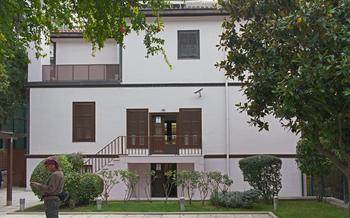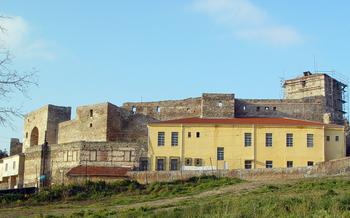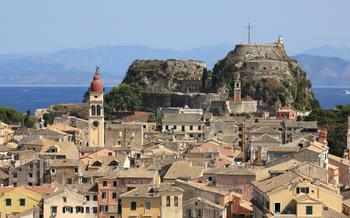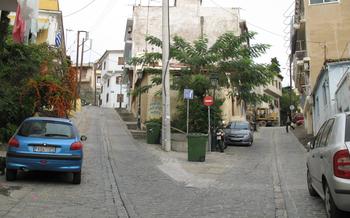
Yedi Kule (Heptapyrgion)
- Thessaloniki’s Fortress: A Historical Overview
- The Walls: A Defensive Masterpiece
- The Seven Towers: A Mystery Unveiled
- Transforming into a Prison: A Dark Chapter
- A Symbol of Freedom: The Liberation
- Exploring the Grounds: Must-See Highlights
- Captivating Exhibits: Unveiling the Past
- Thrilling Guided Tours: Unveiling Secrets
- Festivals and Events: A Cultural Extravaganza
- Getting There: Convenient Transportation Options
- Hours of Operation: Planning Your Visit
- Admission Fees: Preparing for Your Visit
- Dress Code and Etiquette: Showing Respect
- Dining Options: Satisfying Your Taste Buds
- Insider Tip: Unveiling a Hidden Gem
Thessaloniki’s Fortress: A Historical Overview
Thessaloniki’s imposing fortress, known as the Heptapyrgion or Yedi Kule, stands as a testament to the city’s rich and tumultuous past. Its history dates back to the Byzantine era, when it was constructed in the 10th century as part of the city’s fortifications. Over the centuries, it has undergone numerous modifications and additions, reflecting the changing needs and rulers of Thessaloniki.
In the 15th century, the Ottomans conquered Thessaloniki and transformed the fortress into a garrison, adding towers and strengthening its defenses. During the Ottoman period, it became known as Yedi Kule, meaning “Seven Towers” in Turkish, due to the presence of seven prominent towers.
In the late 19th century, the fortress was converted into a prison, serving as a place of confinement for political prisoners and criminals. The prison era left a dark mark on the fortress’s history, and its reputation as a place of suffering and injustice persists to this day.
Today, the fortress has been transformed into a vibrant cultural venue, hosting a variety of exhibitions, events, and festivals. Its unique blend of history, architecture, and cultural significance makes it a must-visit attraction for anyone interested in exploring Thessaloniki’s rich heritage.
The Walls: A Defensive Masterpiece
Thessaloniki's fortress walls are a testament to the city's rich history and strategic importance. Constructed in the 15th century, these imposing fortifications were designed to withstand attacks from both land and sea. The walls feature a complex system of towers, gates, and bastions, each serving a specific defensive purpose.
The fortress walls were built using a combination of stone and brick, with a thickness ranging from 2 to 4 meters. The walls were reinforced with numerous towers, which provided archers and gunners with elevated positions from which to defend the city. The towers were also used as watchtowers, allowing the garrison to keep a close eye on the surrounding area.
In addition to the towers, the walls were also dilengkapi with several gates, which were heavily fortified and could be closed off in times of danger. The most important gate was the Main Gate, which was located on the eastern side of the fortress. The Main Gate was protected by a drawbridge, a portcullis, and a series of machicolations, which allowed the defenders to drop rocks and boiling liquids on attackers.
Thessaloniki's fortress walls proved to be an effective deterrent against attack. The city was never successfully besieged by a foreign power, and the walls remained largely intact until the 19th century. In the 20th century, the walls were restored and opened to the public, and they now serve as a popular tourist attraction.
The Seven Towers: A Mystery Unveiled
The fortress derives its name, Heptapyrgion, meaning "Seven Towers" in Greek, from the seven imposing towers that once stood as formidable guardians of the city. These towers were an integral part of the fortress's defensive system and played a crucial role in repelling enemy attacks. Each tower had its own unique design and purpose, contributing to the overall strength and resilience of the fortress.
Over the centuries, myths and legends have woven their way around the seven towers, captivating the imaginations of locals and visitors alike. One popular legend tells of a beautiful princess who was imprisoned in one of the towers by a jealous stepmother. The princess, with her wit and determination, eventually outsmarted her stepmother and escaped from her confinement, leaving behind a legacy of courage and resilience.
Today, only three of the original seven towers remain standing, each bearing witness to the fortress's rich and storied past. These towers have been carefully restored and preserved, allowing visitors to explore their intricate architecture and marvel at their enduring strength. The Heptapyrgion stands as a testament to Thessaloniki's resilience and the enduring power of its cultural heritage.
Transforming into a Prison: A Dark Chapter
In the 19th century, Thessaloniki’s fortress underwent a somber transformation, transitioning from a symbol of defense to a place of confinement. It became a prison, holding within its walls a multitude of unfortunate souls. The conditions inside were harsh and unforgiving, with overcrowding, poor sanitation, and a lack of basic necessities. Political prisoners, criminals, and innocent individuals alike endured unimaginable suffering within these walls.
One of the most notorious inmates was Eleftherios Venizelos, a prominent Greek statesman who was imprisoned for his political beliefs. His confinement sparked outrage and protests, highlighting the oppressive nature of the prison regime. Other notable prisoners included Jewish intellectuals, political dissidents, and victims of the Greek Civil War.
The prison era left an indelible mark on the fortress, etching a dark chapter in its history. The stories of those who languished within its walls serve as a chilling reminder of the human suffering that occurred here. Today, the fortress stands as a testament to the resilience of the human spirit and the power of freedom.
A Symbol of Freedom: The Liberation
In the annals of Thessaloniki’s history, the liberation of the city from Ottoman rule in 1912 stands as a pivotal moment, etched in the collective memory of its people. The fortress, which had long served as a symbol of oppression and confinement, played a pivotal role in this historic event.
As the Greek army approached the city, the Ottoman garrison retreated within the fortress walls, hoping to make a last stand. However, the Greek forces, aided by the local population, laid siege to the fortress and, after a fierce battle, forced the Ottomans to surrender. The liberation of Thessaloniki was a joyous occasion for the city's inhabitants, who had endured centuries of foreign rule. The fortress, once a symbol of subjugation, was transformed into a symbol of freedom and independence.
To this day, the liberation of Thessaloniki is commemorated each year with a grand celebration held within the fortress walls. This event, known as the "Eleftheria Festival," features music, dance, and theatrical performances that pay homage to the city's rich history and its struggle for freedom. The fortress, standing as a silent witness to the city's past, serves as a poignant reminder of the sacrifices made by those who fought for Thessaloniki's liberation.
Exploring the Grounds: Must-See Highlights
Thessaloniki’s fortress is not just a historical monument but also a visually stunning complex with several must-see highlights. As you wander through the grounds, be sure to take in these captivating features:
-
The Main Gate: Enter through the imposing Main Gate, an architectural masterpiece that sets the tone for your exploration. Admire its intricate carvings, sturdy construction, and the sense of awe it inspires.
-
The Clock Tower: Gaze upon the iconic Clock Tower, a symbol of time and resilience. Marvel at its intricate design, the melodious chimes that echo through the fortress, and its role in marking the passage of history.
-
The Church of St. George: Step into the Church of St. George, a sacred space nestled within the fortress walls. Discover its religious significance, admire its beautiful frescoes and iconography, and feel a sense of tranquility amidst the historic surroundings.
-
The Panoramic Views: Ascend to the ramparts and be rewarded with breathtaking panoramic views of Thessaloniki and its surroundings. From the azure waters of the Thermaic Gulf to the vibrant cityscape, the vistas are simply mesmerizing.
Captivating Exhibits: Unveiling the Past
The Yedi Kule is not just a fortress and a prison, but also a treasure trove of history and culture. Within its walls, three fascinating museums await visitors, each offering a unique perspective on the rich heritage of Thessaloniki.
The Byzantine Museum showcases a stunning collection of artifacts from the Byzantine era, including intricate mosaics, beautifully preserved frescoes, and religious icons. Visitors can trace the evolution of Byzantine art and gain insights into the empire's cultural and spiritual life.
The Jewish Museum delves into the history of the Jewish community in Thessaloniki, one of the oldest and most vibrant in Europe. Through poignant exhibits and personal stories, the museum sheds light on the community's contributions to the city's cultural fabric and its struggles during the Holocaust.
The Folklore and Ethnological Museum celebrates the traditional way of life in Macedonia and Thrace. Visitors can explore exhibits showcasing traditional costumes, household items, and agricultural tools, gaining a deeper understanding of the region's rich cultural heritage and customs.
In addition to these permanent exhibits, the Yedi Kule also hosts a variety of temporary exhibitions throughout the year, featuring diverse themes ranging from contemporary art to historical artifacts. These exhibitions offer visitors a chance to delve deeper into specific aspects of the fortress's past and its connection to the wider world.
Thrilling Guided Tours: Unveiling Secrets
Unveiling the captivating history and legends of the Yedi Kule, guided tours offer an immersive journey through time. Conducted in various languages, these tours delved into the fortress's rich past, from its origins as a Byzantine stronghold to its transformation into a prison and eventual liberation. Expert guides lead visitors through the fortress's intriguing nooks and crannies, sharing tales of battles, sieges, and escapes. They illuminate the architectural features, defensive mechanisms, and cultural significance of the site, bringing the fortress's story vividly to life.
The tours typically cover themes such as the fortress's construction and design, its role in defending the city, the living conditions of prisoners, and the events leading to its liberation. Visitors can expect to learn about the notable inmates who were incarcerated within its walls, including political dissidents, freedom fighters, and ordinary criminals. Guides also share myths and legends associated with the fortress, adding an element of mystery and intrigue to the tour.
The duration of the guided tours varies, typically ranging from one to two hours. The cost of the tours is nominal, and discounts are often available for students, seniors, and families. Visitors are advised to book their tours in advance, especially during peak season, to secure a spot and avoid disappointment. Guided tours offer an exceptional opportunity to delve deeper into the history and significance of the Yedi Kule, providing visitors with a truly memorable and enriching experience.
Festivals and Events: A Cultural Extravaganza
The Heptapyrgion Fortress is not just a historical site but also a vibrant cultural venue that hosts a diverse range of festivals and events throughout the year. These events bring the fortress to life, transforming it into a stage for artistic expression, historical reenactments, and musical performances.
One of the most popular events is the annual Thessaloniki International Film Festival, which showcases a selection of independent films from around the world. The festival screens films in various languages, providing a platform for emerging filmmakers and offering audiences a unique cinematic experience.
Music lovers are treated to the Heptapyrgion Music Festival, which features a lineup of local and international musicians performing a variety of genres, from traditional Greek music to jazz and rock. The festival takes place in the summer months, creating a magical atmosphere under the starry sky.
History buffs can immerse themselves in the past during the Heptapyrgion Historical Reenactment Festival. This festival brings to life scenes from the fortress's rich history, with actors dressed in period costumes reenacting battles, ceremonies, and everyday life within the fortress walls.
The fortress also hosts various art exhibitions, cultural workshops, and educational programs, providing visitors with opportunities to engage with the local culture and learn about the fortress's heritage.
Attending a festival or event at the Heptapyrgion Fortress is a fantastic way to experience the site's unique atmosphere and immerse yourself in the cultural tapestry of Thessaloniki. Check the fortress's official website or local event listings for upcoming events and plan your visit accordingly.
Getting There: Convenient Transportation Options
Thessaloniki's fortress, the Yedi Kule, is easily accessible by various means of transportation, making it a convenient destination for visitors. The fortress is situated within walking distance from the city center, allowing for a pleasant stroll through the vibrant streets of Thessaloniki. Alternatively, numerous public transportation routes, including buses and taxis, connect the fortress to different parts of the city, ensuring seamless travel. For those arriving by car, ample parking options are available in the vicinity of the fortress, providing hassle-free access. The fortress is also wheelchair accessible, catering to visitors with disabilities.
Hours of Operation: Planning Your Visit
The Yedi Kule fortress and its museums are open to the public, inviting history and culture enthusiasts to explore its captivating grounds. To ensure a smooth and enjoyable visit, it's crucial to be aware of the operating hours. The fortress typically opens its gates daily, welcoming visitors from 9:00 AM to 5:00 PM. However, it's worth noting that these hours may vary depending on the season.
During the summer months, from April to October, the fortress extends its hours of operation, allowing visitors to delve deeper into its history and charm. The extended hours during this period are from 8:00 AM to 8:00 PM, providing ample time to explore the fortress at a leisurely pace.
To make the most of your visit, consider arriving early in the morning or late in the afternoon to beat the crowds and enjoy a more intimate experience. This will allow you to wander through the grounds, admire the panoramic views, and delve into the exhibits without feeling rushed.
Admission Fees: Preparing for Your Visit
Visiting the Yedi Kule and its museums comes with an admission fee. The standard ticket price for adults is [amount], while children, students, and seniors can enjoy discounted rates. It's worth noting that admission is free on the first Sunday of each month, allowing visitors to explore the fortress and its treasures without any financial burden.
For those seeking a comprehensive experience, combination tickets are available, offering access to multiple museums and sites within the fortress. These tickets often provide significant savings compared to purchasing individual tickets for each attraction. Advance purchase options are also available online, allowing visitors to secure their tickets in advance and avoid any queues or disappointment.
Dress Code and Etiquette: Showing Respect
When visiting Yedi Kule, appropriate attire is essential to show respect for the historical and cultural significance of the site. While there is no strict dress code, it is generally advisable to dress modestly and avoid revealing or overly casual clothing. Comfortable shoes are recommended as you will be doing a lot of walking on uneven surfaces.
Remember that Yedi Kule is not just a tourist attraction but also a place of historical importance. Be mindful of your behavior and avoid any actions that may be disrespectful to the site or its visitors. Refrain from touching or leaning against the ancient walls and artifacts, and be cautious not to damage or disturb anything within the fortress.
Photography and videography are generally allowed within the fortress, but it is important to be respectful of other visitors and the privacy of any ongoing events or activities. Using a flash or tripod may be restricted in certain areas, so it is best to check with the staff beforehand.
By following these guidelines, you can contribute to preserving the integrity and atmosphere of this historic site while ensuring a respectful and enjoyable experience for all visitors.
Dining Options: Satisfying Your Taste Buds
After exploring the rich history and cultural heritage of the Yedi Kule, you may find yourself in need of sustenance. Fortunately, the fortress offers a variety of dining options to satisfy your taste buds and enhance your overall experience.
Within the fortress walls, you'll find several cafes and restaurants that offer a range of culinary delights. From traditional Greek cuisine to international fare, there's something to suit every palate. Whether you're in the mood for a quick snack or a leisurely meal, you'll find plenty of options to choose from.
For those seeking a taste of authentic Greek cuisine, the traditional tavernas within the fortress are a must-visit. These charming establishments offer a warm and welcoming ambiance, along with a menu featuring classic Greek dishes such as moussaka, pastitsio, and souvlaki.
If you prefer a more international dining experience, you'll find several restaurants offering a variety of cuisines, including Italian, French, and Asian. These restaurants often feature outdoor seating areas, allowing you to enjoy your meal while taking in the stunning views of the city and the surrounding landscape.
No matter what your culinary preferences may be, you're sure to find something to satisfy your taste buds at the Yedi Kule. So, take a break from your historical exploration and indulge in a delicious meal while immersing yourself in the fortress's unique atmosphere.
Insider Tip: Unveiling a Hidden Gem
Beyond the visible ramparts and towers of the Heptapyrgion, a hidden world awaits exploration. Concealed beneath the fortress's surface lies a labyrinth of underground tunnels and secret chambers, whispering tales of a forgotten past. These hidden spaces once served as storage rooms, dungeons, and escape routes, adding layers of intrigue to the fortress's already rich history.
To uncover these hidden gems, visitors can book a special tour or seek permission from the authorities. These tours offer a unique glimpse into the fortress's lesser-known secrets, revealing the stories of those who once inhabited these subterranean realms.
As you venture into the darkness, the tunnels transport you back in time. The walls bear the marks of centuries, etched by the footsteps of soldiers, prisoners, and perhaps even royalty. Discover hidden chambers that once echoed with the sounds of whispered conversations, strategic planning, and the clanging of chains.
Unveiling these hidden spaces is like piecing together a puzzle, each chamber adding a fragment to the fortress's grand narrative. It's an experience that will leave you with a deeper appreciation for the Heptapyrgion's rich history and the secrets it holds.





